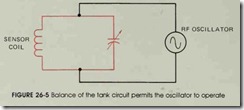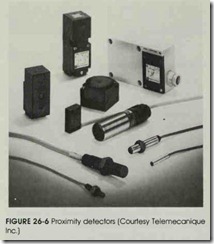Objectives
After studying this unit, the student will be able to:
• Describe the operation of proximity detectors
• Describe different types of proximity detectors
APPLICATIONS
Proximity detectors are basically metal detec tors. They are used to detect the presence or ab sence of metal without physically touching it. This prevents wear on the unit and gives the detector the ability to sense red hot metals. Most proximity detectors are designed to detect ferrous metals only, but there are some units that detect all metals.
CIRCUIT OPERATION
There are several methods used to make proximity detectors. One method is shown in fig ure 26-1. This is a very simple circuit intended to illustrate the principle of operation of a proximity detector. The sensor coil is connected through a series resistor to an oscillator. A voltage detector, in this illustration a voltmeter, is connected across the resistor. Since ac voltage is applied to this cir cuit, the amount of current flow is determined by the resistance of the resistor and the inductive re actance of the coil. The voltage drop across the resistor is proportional to its resistance and the amount of current flow.
If ferrous metal is placed near the sensor coil, its inductance increases in value. This causes an increase in inductive reactance, and a decrease in the amount of current flow through the circuit. When the current flow through the resistor is de creased, the voltage drop across the resistor de creases also, figure 26-2. The drop in voltage can be used to turn relays or other devices on or off.
This method of detecting metal does not work well for all conditions. Another method which is more sensitive to small amounts of metal is shown in figure 26-3. This detector uses a tank circuit tuned to the frequency of the oscillator. The sensor head contains two coils instead of one. This type of sensor is a small transformer. When the tank circuit is tuned to the frequency of the oscillator, current flow around the tank loop is high. This causes a high voltage to be induced into the secondary coil of the sensor head.
When ferrous metal is placed near the sensor as shown in figure 26-4, the inductance of the coil increases. When the inductance of th coil changes, the tank circuit no longer resonates to the frequency of the oscillator. This causes the current flow around the loop to decrease signifi cantly. The decrease of current flow through the sensor coil causes the secondary voltage to drop also.
Notice that both types of circuits depend on a ferrous metal to change the inductance of a coil. If a detector is to be used to detect nonferrou s metals, some means other than changing the inductance of the coil must be used. An all-metal detector uses a tank circuit as shown in figure 26-5. All-metal detectors operate at radio frequencies, and the balance of the tank circuit is used to keep the oscillator running. If the tank circuit becomes unbalanced, the oscillator stops operating. When a nonferrous metal, such as aluminum, copper, or brass, is placed near the sensor coil, eddy currents are induced into the surface of the metal. The in duction of eddy currents into the metal causes the tank circuit to become unbalanced and the oscil lator to stop operating. When the oscillator stop’s operating, some other part of the circuit signals an output to turn on or off.
Proximity detectors used to sense all types of metals will sense ferrous metals better than nonferrous. A ferrous metal can be sensed at about three times the distance of a nonferrous metal.
MOUNTING
Some proximity detectors are made as a single unit. Other detectors use a control unit which can be installed in a relay cabinet and a sensor which is mounted at a remote location. Figure 26-6 shows different types of proximity detectors. Re gardless of the type of detector used, care and forethought should be used when mounting the sensor. The sensor must be near enough to the target metal to provide a strong positive signal, but it should not be so near that there is a possi bility of the sensor being hit by the metal object. One advantage of the proximity detector is that no physical contact is necessary between the detector and the metal object for the detector to sense the object.
Sensors should be mounted as far away from other metals as possible. This is especially true for sensors used with units designed to detect all types of metals. In some cases it may be necessary to mount the sensor unit on a nonmetal surface such as wood or plastic. If proximity detectors are to be used in areas that contain metal shavings or metal dust, an effort should be made to place the sensor in a position that will prevent the shavings or dust from collecting around it. In some installations it may be necessary to periodically clean the metal shavings or dust away from the sensor.
REVIEW QUESTIONS
1. Proximity detectors are basically —————–
2. What is the basic principle of operation used with detectors designed to detect only ferrous metals?
3. What is the basic principle of operation used with detectors designed to detect all types of metals?
4. What type of electric circuit is used to increase the sensitivity of the proximity detector?
5. What type of proximity detector uses an oscillator that operates at radio frequencies?





